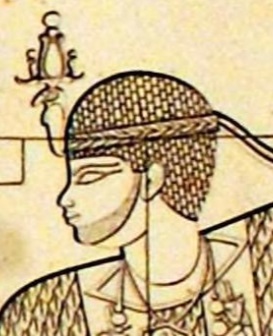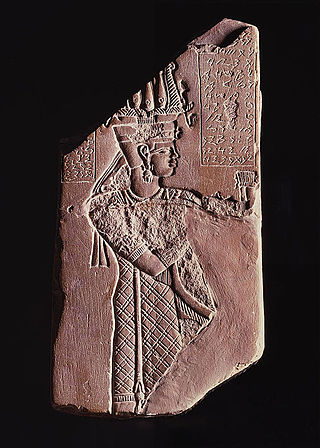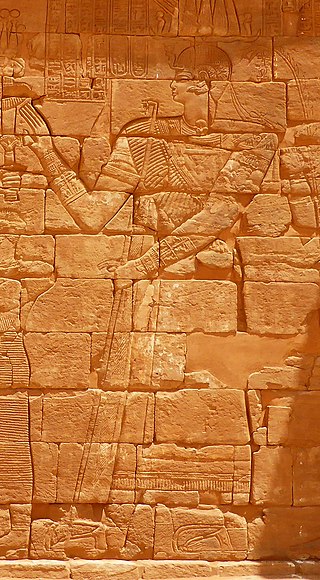
Natakamani, also called Aqrakamani, was a king of Kush who reigned from Meroë in the middle of the 1st century CE. He ruled as co-regent together with his mother Amanitore. Natakamani is the best attested ruler of the Meroitic period. He and Amanitore may have been contemporaries of the Roman emperor Nero.

The Blemmyes were an Eastern Desert people who appeared in written sources from the 7th century BC until the 8th century AD. By the late 4th century, they had occupied Lower Nubia and established a kingdom. From inscriptions in the temple of Isis at Philae, a considerable amount is known about the structure of the Blemmyan state.

Amanishakheto was a queen regnant (kandake) of Kush who reigned in the early 1st century AD. In Meroitic hieroglyphs her name is written "Amanikasheto". In Meroitic cursive she is referred to as Amaniskheto qor kd(ke) which means Amanishakheto, Qore and Kandake.

Baskakeren was a king of Kush. He was likely a son of King Malewiebamani and the younger brother of King Amanineteyerike. He succeeded King Amanineteyerike to the throne.

Shanakdakhete, also spelled Shanakdakheto or Sanakadakhete, was a queen regnant of the Kingdom of Kush, ruling from Meroë in the early first century AD. Shanakdakhete is poorly attested, though is known to have constructed a temple in Naqa.

Amanikhareqerem was a King of Kush who ruled during the late 1st century AD. In older research he was placed into the 2nd century AD. or possibly earlier. His chronological position means that he may have succeeded Shorkaror and preceded Amanitenmemide. It is impossible to securely identify where Amanikhareqerem was buried. It has been suggested that he was buried in the pyramid Beg. N 16 in Meroë.

Aryamani was a Nubian king.
Aktisanes is a Nubian king who is mentioned by the Greek historian Hecataeus of Abdera. He is perhaps identical with Menmaatre-Setepenamun Gatisen known from Nubian sources.
Sekhmakh was the wife of the Nubian king Nastasen, who ruled in the Fourth century BC.

Tarekeniwal was a Kushite King of Meroë of whom little is known. He likely reigned in the second half of the 2nd century AD. Tarekeniwal is only known from his pyramid in Meroe. His name appears on the pylon of the cult chapel in front of the pyramid, which was in modern times restored. The chapel and its decoration is still well preserved.

Amanitore, also spelled Amanitere or Amanitare, was a queen regnant of the Kingdom of Kush, ruling from Meroë in the middle of the 1st century CE. She ruled together with her son, Natakamani. The co-reign of Amanitore and Natakamani is a very well attested period and appears to have been a prosperous time. They may have been contemporaries of the Roman emperor Nero.

Arqamani was a Kushite King of Meroë dating from the late 3rd to early 2nd century BCE.
Adikhalamani was a king of Kush, ruling from Meroë in the first half of the 2nd century BCE.

Tanyidamani was a Kushite king of Meroë who ruled in the second half of the 2nd century BCE. He was most likely the son of king Adikhalamani and Queen Nahirqo.

Arnekhamani was a Nubian king of the Kushite Kingdom in the third century BC. The king is mainly known from his building activity at the Musawwarat es-Sufra temple complex. The main temple complex at this place was built by Arnekhamani, but was never finished. Most likely the king died before completing the temples.

Amanitaraqide was a king of the kingdom of Kush, ruling from Meroë. The timeframe of his reign and the location of his burial are uncertain and disputed.

Nahirqo is the name attributed to a Kushite queen regnant buried in pyramid Beg N. 11 in Meroë. Nahirqo is the earliest known woman to have ruled the Kingdom of Kush, reigning in the middle second century BC. Prior to her own reign, Nahirqo is believed to have been the queen consort of King Adikhalamani.
Shesepankhenamen Setepenre is the Horus name of an otherwise unknown king of Kush, ruling from Meroë in the second half of the 3rd century BCE. His personal name is unknown. The Horus name is known only from fragmentary inscriptions on a stray block in Meroë's northern cemetery. No burial site has been identified for this king.
Tabirqo was a king of Kush, ruling from Meroë in the first half of the 2nd century BCE. Tabirqo's name is known only from his tomb, Beg. N 9 in Meroë.














